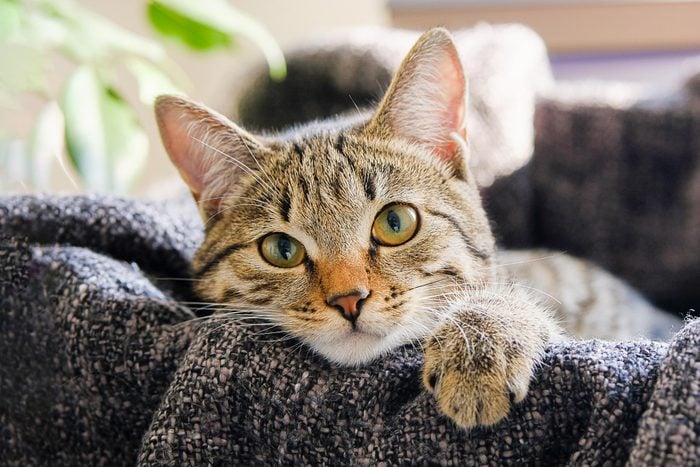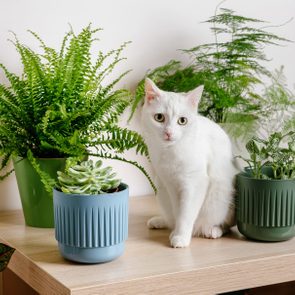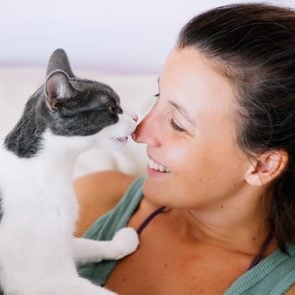How Long Is It OK to Leave Your Cat Home Alone?
Updated: Mar. 05, 2024

Sure, cats are independent, but they still crave human interaction. Here's how long you can safely leave your furry pal home alone, according to cat behavior experts.
Cats are fascinating creatures. They’re adorable and affectionate yet moody and aloof. They’re clever and cunning but look like total maniacs when they have cat zoomies. And they’re much more self-sufficient than dogs (no offense, Fido!). After all, they have no need for regular walks, using a litter box to go potty instead. It’s enough to make you wonder: Just how long can you leave a cat alone?
Spoiler alert: It’s not as long as you think. Cats actually thrive with human interaction, which is what makes it possible to train a cat to do fun tricks and teach them to keep off the counters. Yet their self-sufficiency has limits. We asked cat behavior experts what those limits are—here’s what they said.
Get Reader’s Digest’s Read Up newsletter for more pet insights, humor, cleaning, travel, tech and fun facts all week long.
About the experts
|
How long can you leave an adult cat home alone?
Cats are lower-maintenance pets compared with dogs because they don’t rely on us to take them for walks and potty breaks, but that kind of independence doesn’t mean they don’t crave social contact. Cats can experience boredom and stress when left alone for too long.
“An adult cat can generally be left alone for 24 to 48 hours, provided they can access food, water and a clean litter box,” says Michael Thompson, DVM, lead veterinarian and cat behaviorist at Pets Food Safety.
You might be wondering, How long can you leave a cat alone if you just adopted them? It’s essential to let them settle in and acclimate to their new home before leaving them overnight. Every cat is different, and some may experience more stress than others when left alone, so Dr. Thompson recommends waiting at least three weeks before leaving a newly adopted kitty alone for extended periods.
If you’re expanding your feline family and introducing a new cat to a kitty who has enjoyed its reign in the house, be sure that both are getting along before you leave them alone together. This get-to-know-you phase may take days or a few weeks. In the meantime, if you have to leave the home, separate them into different areas of the house, each with its own food, water and litter box.
How long can you leave a kitten home alone?
Even if you just need to make a quick run to the corner store, it’s hard to think about leaving your adorable kitty home alone. So how long can you leave a cat alone when it’s less than a year old?
Like human infants, kittens require more frequent attention and care than adult cats. “Kittens have higher energy levels and need more social interaction and playtime. Ideally, they should be left unsupervised for, at most, four to six hours,” says Dr. Thompson.
When introducing a new kitten to a house already ruled by a feline overlord, you’ll want to make sure they’re playing nice before you leave them alone together, just as you would for adult cats. The making-friends phase can take days or weeks for kittens too. If they must stay home alone and the fur is still flying, Dr. Thompson recommends following the same practice for kittens as you would adult cats: Keep them in separate rooms with their own litter box, food and water.
Risks of leaving a cat alone for too long
When considering how long to leave a cat alone, it’s vital to weigh the physical and mental health risks to your cat, including its age. “Mentally, kittens are more susceptible to anxiety, fear and behavioral problems due to their higher activity levels and need for stimulation,” says Dr. Thompson. “Physically, they may not receive the necessary feeding and monitoring for their growth and development.”
Even though adult cats sleep a lot and have the capacity to take care of themselves for longer periods of time, they still have their share of concerns. “Mentally, they may experience boredom, loneliness and stress,” he says. “This could result in behavioral issues such as anxiety, depression or destructive behavior. Physically, a lack of attention may lead to neglect of any underlying health issues that might arise.”
How to prep your cat for being home alone
When taking in all the considerations of how long you can leave a cat alone, there’s one essential step you shouldn’t skip: teaching your cat to get fur-miliar with the process of your leaving so it’s not a big deal when you say bye-bye.
For example, make grabbing your keys a non-event. “Regularly grab your keys, put them in your pocket and sit on the couch. Then put the keys back after a little bit,” says Joey Lusvardi, a cat behaviorist and the owner of Class Act Cats in Minneapolis. You can also drive this home by pairing the action with treats or playtime so your cat learns that grabbing the keys means good things are coming.
Speaking of familiarity, one of the things cats hate is a disruption in their regular routine. If a new schedule will take you away from the house more often, try to get your cat used to it gradually before it happens. Cats thrive on predictability, and this will help them adjust to a new routine.
“Start out leaving for short periods of time and then gradually increase the amount of time you will be out. This helps cats learn that you will be coming back eventually and reduces the stress that comes from the changes in their schedule,” says Lusvardi.
Tips for keeping your cat safe while you’re away
If your little lion could talk, it would say that providing basic necessities is the bare minimum. “Ensuring they have enough mental stimulation during this time is essential,” says Dr. Thompson. Here’s how to ensure your cat is happy, safe and comfy while you’re away.
Provide access to drinking water and food
Access to clean drinking water and food is a no-brainer. But what if your kitty splashes and plays with its water and gets more on the floor than in its mouth? What if your pet is persnickety and prefers fresh refills several times a day?
Think about buying an automatic cat water fountain. Pair it with an automatic cat feeder for consistent meal times and perfect portions—you’ll often find one for a steal during annual pet sales.
Offer a squeaky-clean litter box
One of the amazing things about cats is that they instinctively know how to use a litter box. Still, they tend to find dirty litter boxes a-paw-ling (who can blame them?!) and might find a cleaner place to go, like your bed.
A clean litter box with plenty of fresh litter is a must. Make both your lives easier and order a self-cleaning litter box.
Furnish enrichment activities
Enrichment activities provide mental stimulation and stave off the boredom that can lead to destructive behaviors like chewing or peeing on the carpet. Satisfy your kitty’s cerebral pursuits by leaving out fun and stimulating cat toys for it to play with while you’re gone.
Lusvardi also says that growing cat grass, putting out food puzzles and installing cat window perches (great for watching the bird feeder and those suspicious squirrels) are fun ways to keep your cat happy and content.
But if your cat is a fan of those wand and feather toys, take note: Since you can’t supervise your pet while it plays with these toys, you may want to hide them while you’re out of the house. You don’t want your cat to get tangled up in the string.
Provide a comfy environment
“This means ensuring your cat has places to rest, the temperature is comfortable and they have access to all their favorite resources,” says Lusvardi.
And don’t leave your cat in the dark! Set up simple light timers that will go on and off as if you were home to provide a sense of familiarity.
Close doors to off-limit rooms
Some cats hate water, while others love to play in it. Close the bathroom doors if you’re worried about your curious kitty falling in the toilet. (Putting the lid down isn’t enough for clever cats!) Consider other rooms that could pose safety hazards and shut the doors before you leave.
What to do if you’ll be away from home longer
These days, cats can fly on a plane in a cat carrier at your feet, and many are allowed in pet-friendly hotels. But sometimes it’s just not possible to take your furry friend with you. So, just how long can you leave a cat alone when you have to travel for business or a vacation?
As Dr. Thompson mentioned, cats shouldn’t be left to their own devices for more than 24 to 48 hours. And that might even be too long for cats who get stressed and lonely when home alone. “Each cat is unique, so while the general guidelines apply, it’s essential to consider the individual needs and personalities of your cats when making decisions,” says Dr. Thompson.
So what kitty-care options do you have? Friends or family members can stay at your home or at least check in daily, and cat sitters can pop in to check on your kitty or even stay at your home. Additionally, cat boarding is available, but it might not be the cat’s meow.
“Cat sitters are generally going to be less stressful than taking your cat to a boarding facility, though there are some exceptions. If your cat is going to get more attention and enrichment at the boarding facility, it may be better than leaving them at home,” says Lusvardi. The same applies if you have two cats who aren’t getting along and if you can’t find a cat sitter.
Speaking of cat sitters, a perfect setup would include 30-minute check-ins, twice a day, at the same time each day. “This will keep things consistent and predictable for your cat,” Lusvardi says. If you have more than one cat, longer check-ins might be necessary to ensure they each get enough attention.
Want to learn more about the weird quirks and funny habits of your pets? Dr. Phur on The Pet Collective is a seasoned doggy doctor serving up inside information plus the best tips and tricks for the care of all your animal friends.
Why trust us
At Reader’s Digest, we’re committed to producing high-quality content by writers with expertise and experience in their field in consultation with relevant, qualified experts. We rely on reputable primary sources, including government and professional organizations and academic institutions as well as our writers’ personal experience where appropriate. We verify all facts and data, back them with credible sourcing, and revisit them over time to ensure they remain accurate and up to date. Read more about our team, our contributors and our editorial policies.
Sources:
- Michael Thompson, DVM, founder and lead veterinarian and cat behaviorist at Pets Food Safety in Austin, Texas. Dr. Thompson has a lifelong passion for animal health and specializes in pet nutrition. He lives with his cat, Nimbus, and dog, Jax, a Jack Russell terrier.
- Joey Lusvardi, certified cat behavior consultant and the owner of Class Act Cats in Minneapolis. He also works as a psychiatric physician assistant and trains cats to become therapy animals. He lives with a former stray Siamese cat named Prozac.



